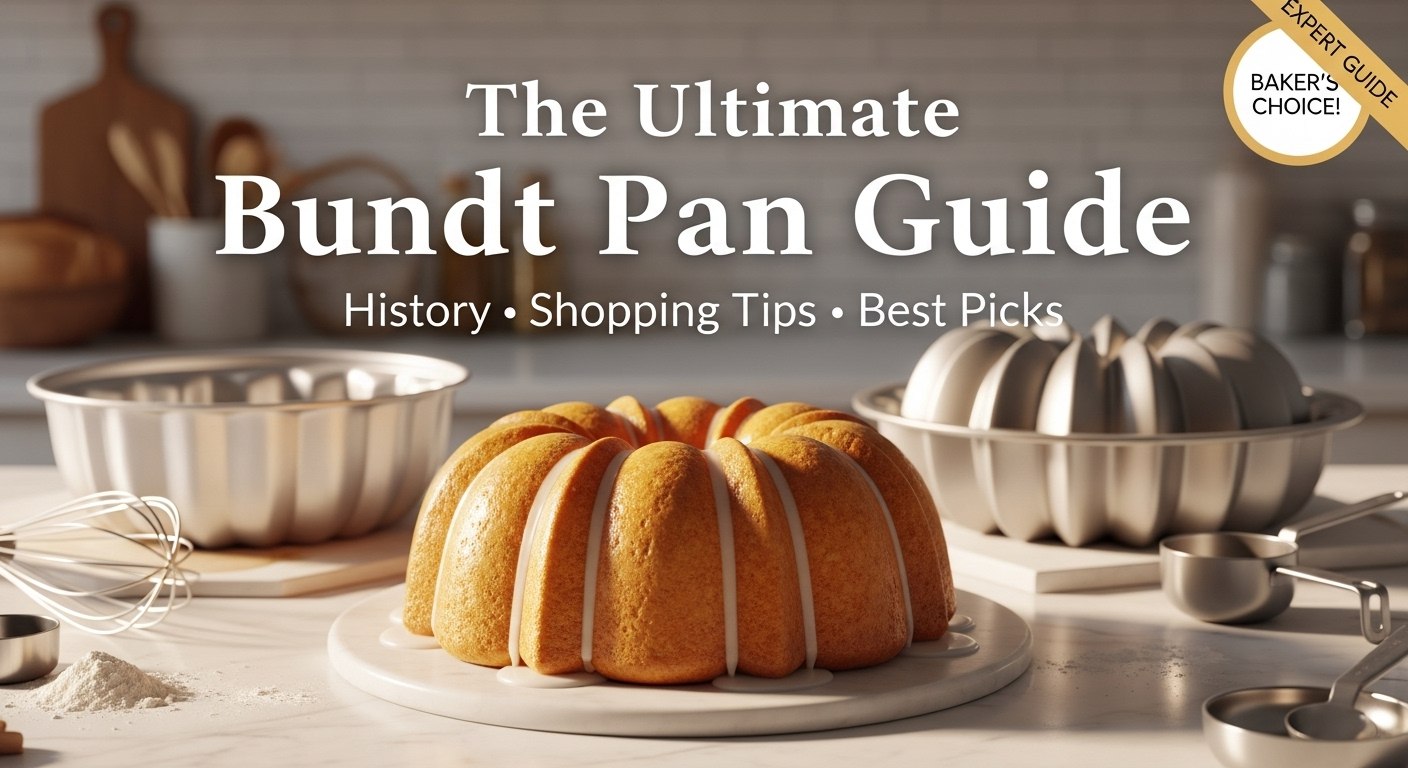
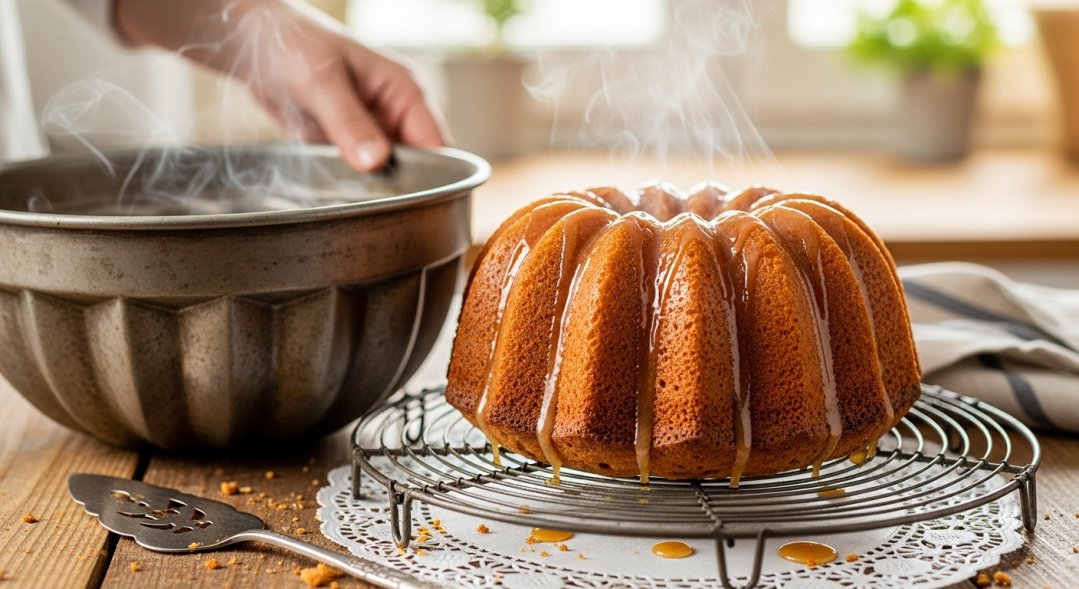
There's something magical about pulling a perfectly baked bundt cake out of the oven. That satisfying moment when you flip it over, lift the pan, and reveal those beautiful ridges and swirls—it never gets old. I've been baking with bundt pans for years now, and I can honestly say that once you understand what makes a good one (and where to find it), your baking game changes completely.
Whether you're here because you're tired of cakes that stick to the pan, you're hunting for mini bundt pans for a party, or you're just curious about the story behind this iconic baking tool, I've got you covered. Let's dive into everything you need to know about bundt pans.
The Fascinating History of the Bundt Pan
Who Invented the Bundt Pan?
Here's a fun fact that surprises most people: the bundt pan was invented by a guy named H. David Dalquist, who founded Nordic Ware back in the 1940s. But he didn't just wake up one day and decide to create this shape. The story is actually pretty charming.
In 1950, members of the Minneapolis chapter of Hadassah Society (a Jewish women's organization) approached Dalquist with a request. They wanted a pan that could recreate a traditional European cake called "Bundkuchen" that many of them remembered from their childhoods. The problem? No American company was making anything like it.
Dalquist took on the challenge and created what we now know as the bundt pan. The name "Bundt" comes from the German word "Bund," which means a gathering of people—perfect for a cake that brings everyone together. Nordic Ware even trademarked the name, which is why you'll sometimes see similar pans called "fluted tube pans" from other brands.
When Was the Bundt Pan Invented?
The bundt pan was born in 1950, but here's the twist: it didn't become popular right away. For sixteen years, it was basically a kitchen secret that only a small group of bakers knew about. Sales were modest at best, and it looked like the bundt pan might fade into obscurity.
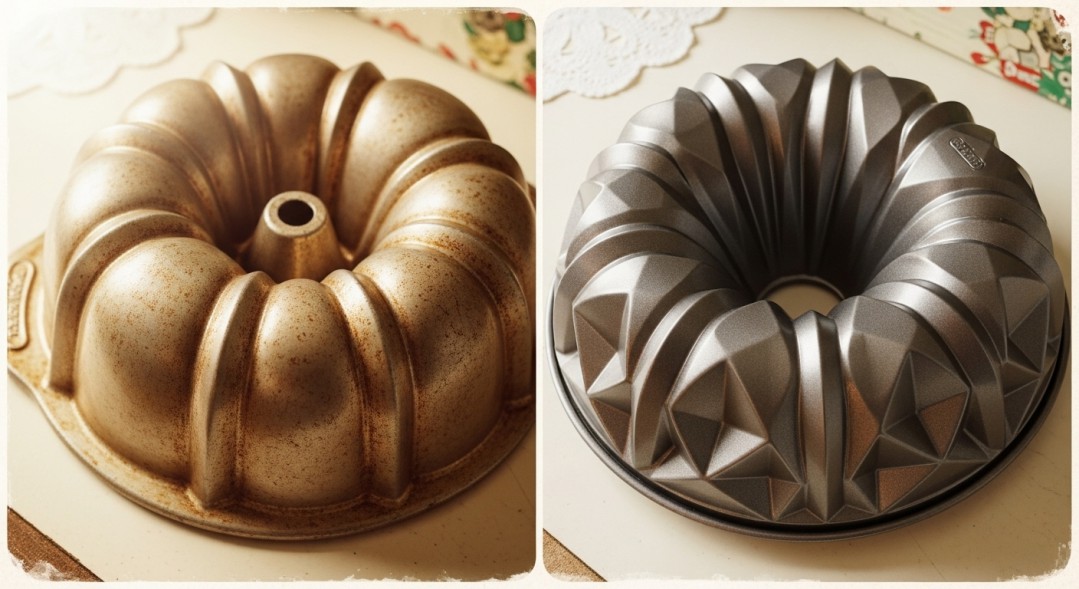
Then came 1966, and everything changed. A Texas baker named Ella Helfrich entered the Pillsbury Bake-Off with her "Tunnel of Fudge Cake," which she made in—you guessed it—a bundt pan. She took second place, and suddenly everyone in America wanted to know what this mysterious pan was and where they could get one.
Nordic Ware couldn't keep up with demand. The bundt pan became a cultural phenomenon, and it's remained a staple in American kitchens ever since. I actually inherited my first bundt pan from my grandmother, who bought hers sometime in the 1970s. That pan is still going strong, which tells you something about the quality of these things when they're made right.
Where to Buy Bundt Pans: Your Complete Shopping Guide
When I started seriously collecting bundt pans (yes, I admit it—I have a problem), I quickly learned that not all shopping destinations are created equal. Here's what I've discovered about where to find the best selection and deals.
Online Retailers
Amazon is probably where most people start, and for good reason. The selection is massive, you can read hundreds of customer reviews (which I always do before buying), and Prime shipping means you can be baking by the weekend. I've bought at least four bundt pans from Amazon, and the convenience is unbeatable. Just watch out for knockoff brands that look similar to Nordic Ware but don't perform the same way.
Williams Sonoma is where I go when I'm feeling fancy or looking for something special. Their bundt pans tend to be on the premium side, but the quality is consistently excellent. They often carry exclusive designs and seasonal patterns that you won't find anywhere else. I got my stunning Heritage bundt pan from Williams Sonoma during a holiday sale, and it's become my go-to for special occasions.
Sur La Table is another fantastic option for serious bakers. They stock a great range of specialty designs, and their staff actually knows what they're talking about if you're shopping in-store. I once spent twenty minutes discussing bundt pan coatings with an employee there, and I learned more than I expected.
Don't sleep on the Nordic Ware official website either. Since they're the original manufacturer, they have designs you simply can't find anywhere else. Plus, buying directly from them means you're getting the real deal with a full warranty. I treat myself to one pan from their site every year around my birthday.Physical Stores
If you're like me and prefer to touch and feel before buying, physical stores have their advantages. Target and Walmart both carry bundt pans, and they're your best bet for budget-friendly options. The Wilton brand pans you'll find there are perfectly decent for occasional baking, though they won't last as long as a Nordic Ware.
Bed Bath & Beyond (when locations are still open) typically has a solid mid-range selection. Their famous coupons can make a premium pan much more affordable—I've snagged some great deals this way.
Here's an insider tip: HomeGoods and TJ Maxx can be absolute goldmines if you're patient and willing to hunt. I've found Nordic Ware pans there for nearly half the regular price. The catch is that inventory is unpredictable, so you have to grab them when you see them.
Kitchen specialty stores in your area are worth checking out too. They often carry higher-end options and can offer personalized advice based on your baking needs.
Shopping Tips from Experience
Expect to pay anywhere from $15 for a basic non-stick pan to $50+ for premium Nordic Ware designs with intricate details. My sweet spot is around $30-40, which gets you a quality pan that'll last for years.
The absolute best time to buy is right after the holidays—think January and early February. Retailers are clearing out inventory, and I've scored some incredible deals during these periods. Black Friday can be good too, but honestly, the post-holiday sales are often better.
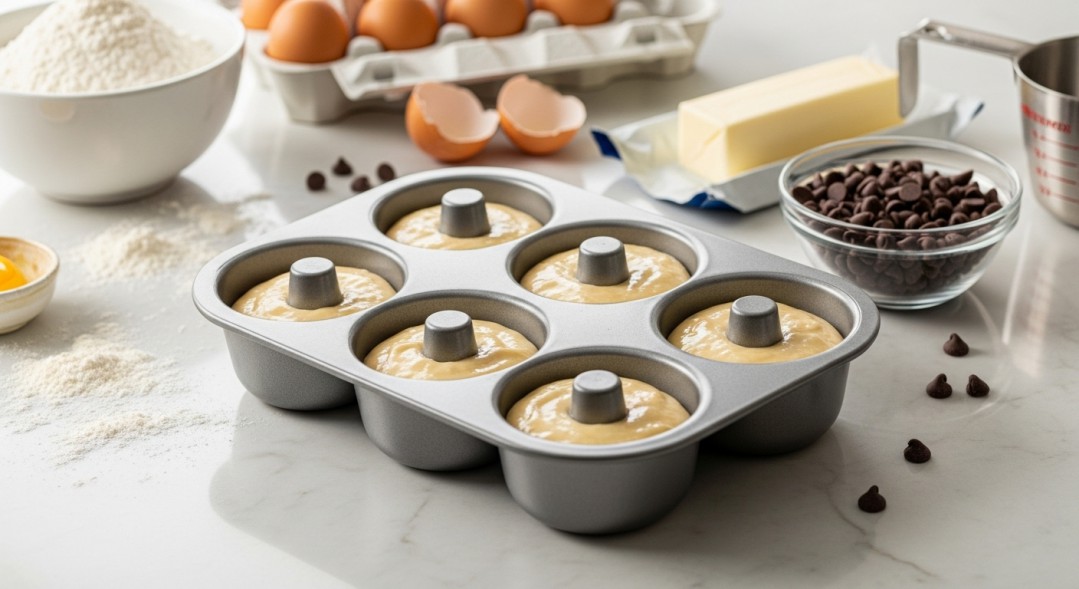
Where to Buy Mini Bundt Pans
Mini bundt pans deserve their own section because they're not just cute—they're genuinely useful. I was skeptical at first (did I really need another pan taking up cabinet space?), but now I use my mini bundt pan almost as much as my full-sized ones.
Best Sources for Mini Bundt Pans
You can find mini bundt pans at all the retailers I mentioned above, but here's what to know: there are two main types. Six-cavity pans give you larger individual cakes (perfect for serving one per person), while twelve-cavity pans make adorable bite-sized versions that are great for parties or gift-giving.I own both types, and I reach for the six-cavity version more often. The twelve-cavity pans are fun, but the cakes are so small that they bake really fast—we're talking 12-15 minutes—and you have to watch them like a hawk to prevent over-baking.
You can also buy individual mini bundt molds that aren't connected, which gives you more flexibility in how many you bake at once. These work well if you have limited oven space or want to experiment with different batters in the same baking session.
Why Mini Bundt Pans Are Worth It
I'll be honest: I bought my first mini bundt pan on a whim for a baby shower, thinking I'd use it once and forget about it. That was three years ago, and it's become one of my most-used pans.
Portion control is the biggest benefit. Individual cakes mean people can have their own serving without cutting and plating, which is fantastic for gatherings. No awkward "is this piece too big?" moments.
They're also perfect for gifting. I've started a tradition of baking mini bundts for neighbors during the holidays, wrapped in cellophane with a ribbon. People love receiving something homemade that looks this professional.
The faster baking time is another win. When I'm short on time but still want to make something special, mini bundts are my solution. They bake in about 20-25 minutes (for six-cavity pans), compared to 45-60 minutes for a full-sized bundt.
Plus, you can make multiple flavors at once. I've done chocolate in three cups and lemon in the other three, which lets guests choose their preference. Try doing that with a regular bundt pan!
What Is the Best Bundt Pan? Key Features to Consider
This is where things get interesting, because "best" really depends on what you value and how often you bake. I've learned this through trial and error—and yes, I've had my share of disasters with cheap pans.
Material Matters
Cast aluminum is the gold standard, and it's what Nordic Ware uses for their pans. These distribute heat incredibly evenly, which means no hot spots that overbake parts of your cake while leaving other sections underdone. My Nordic Ware pans have lasted decades (remember that inherited one I mentioned?), and they still perform like new.
Non-stick coatings vary wildly in quality. The premium non-stick coatings on good pans are worth every penny—your cakes literally slide right out. But cheaper non-stick coatings can start flaking after a dozen uses, which is frustrating and potentially unsafe. I learned this the hard way with a discount pan that looked great but started peeling within months.
Silicone bundt pans are the new kids on the block, and I have mixed feelings about them. On the plus side, nothing sticks to silicone—like, nothing. Release is absolutely foolproof. The downsides? They don't brown cakes as nicely, they're floppy and awkward to move when full of batter, and the cakes don't develop that beautiful crispy exterior that I love. I use mine occasionally for delicate cakes that I'm worried about breaking, but it's not my first choice.
I've never personally used a stoneware or ceramic bundt pan, but I've heard they hold heat well and create a beautiful crust. They're heavier and more fragile than aluminum, which gives me pause.
Size Considerations
Most bundt pans hold between 10 and 15 cups of batter. My everyday pan is a 12-cup, which works for most recipes. If you're baking for a crowd, the 15-cup versions are helpful, but make sure your oven can accommodate the larger size—I've seen people struggle with clearance issues.
For mini bundt pans, a 6-cup capacity pan (with six individual cavities) is the most versatile. You can always bake multiple batches if you need more, but the cakes are a proper serving size.
Design and Release Quality
Here's what I've learned about those gorgeous intricate designs: they look amazing, but they can be tricky. The more detailed the pattern, the more careful you need to be with greasing and flouring. My Nordic Ware Cathedral pan is stunning, but I have to be meticulous about preparation or I'll lose some of those beautiful details when I unmold the cake.
Simpler patterns are more forgiving. If you're new to bundt baking or get anxious about cake release, start with a pan that has shallower grooves and less elaborate designs.
Heat distribution is critical but hard to judge until you've actually baked with a pan. This is why I always check reviews before buying. Cheaper pans often have thin spots that create uneven baking, leaving you with an overbaked edge and an underdone center.
Durability varies dramatically. My Nordic Ware pans show almost no wear after years of use. A cheap pan I bought "just to try a different shape" warped after about six months, making it wobble on the counter and bake unevenly.
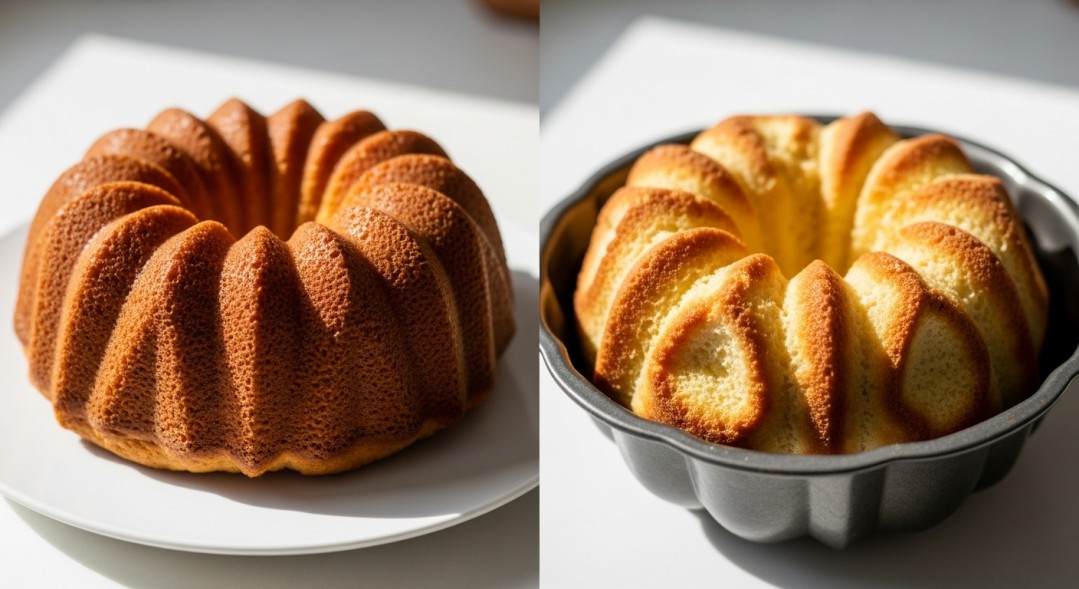
Top Recommendations Based on Real Experience
Best Overall: Nordic Ware Anniversary Bundt Pan - This is the classic for a reason. It's the pan I recommend to everyone who asks. The design is beautiful without being overly complicated, it releases like a dream, and it'll outlast every other pan in your kitchen. Mine has baked at least fifty cakes and looks brand new. Worth every penny of the $40-45 price tag.
Best Budget: Wilton Recipe Right Non-Stick Bundt Pan - For around $15-20, this is a solid entry-level option. It's not going to last twenty years, but if you're baking once a month or just want to try bundt cakes without investing much, it's perfectly adequate. I keep one as a backup pan for when I'm baking multiple cakes.
Best for Intricate Designs: Nordic Ware Platinum Collection - These are the show-stoppers. The Cathedral, Stained Glass, and Bavarian designs from this collection create cakes that look like artwork. They cost more ($45-55), and they require more careful preparation, but the wow factor is unmatched. I save these for special occasions when I want to impress.
Best Mini: USA Pan Bakeware Mini Fluted Cake Pan - Heavy-duty construction and excellent non-stick performance make this my favorite mini pan. It's commercial-grade quality, which means it costs a bit more ($30-35) than some mini pans, but the even baking and consistent results are worth it.
Best Silicone: Silicone Bundt Pan Options - If you're set on silicone, look for thicker, reinforced pans with some structure to them. The super-thin ones are nightmare to handle. I have a Silpat brand one that works decently, but again, I only use it when absolutely necessary.Price vs. Quality: When to Invest
I used to think spending $40 on a cake pan was ridiculous. Then I bought a cheap bundt pan for $12, had three cakes stick catastrophically, and ended up buying a Nordic Ware anyway. Do the math: I wasted money on the cheap pan, wasted ingredients on failed cakes, and wasted time on frustration.
Now I follow this rule: if you're going to bake more than a few times a year, invest in a quality pan upfront. It'll save you money, stress, and disappointment in the long run. If you're truly just experimenting to see if you like bundt cakes, then sure, grab a budget option first.
The performance gap between a $15 pan and a $40 pan is enormous. The gap between a $40 pan and a $60 pan? Much smaller. There are diminishing returns at the premium end.
Care and Maintenance Tips
Taking care of your bundt pan properly makes all the difference in how long it lasts and how well it performs. I've developed a routine that keeps my pans in perfect condition.
Greasing technique is everything. I use a pastry brush and melted butter (or shortening) to get into every single ridge and crevice. Then I dust with flour and tap out the excess. Some people swear by baking spray with flour, and that works too, but I'm old-school. For chocolate cakes, I use cocoa powder instead of flour so I don't get white residue on the finished cake.
Here's a game-changer I discovered: let the cake cool in the pan for exactly 10-15 minutes before inverting. Too soon and it might break; too long and it starts sticking as it cools. I set a timer for this.
Cleaning should be gentle. I hand-wash my bundt pans with warm soapy water and a soft sponge—never steel wool or abrasive scrubbers that can damage the non-stick coating. Dishwashers are controversial; Nordic Ware says their pans are dishwasher-safe, but I've heard enough stories of coatings degrading that I don't risk it.
Storage is simple: I nest my pans carefully to save space, with paper towels between them to prevent scratching. Some people hang theirs on hooks, which looks great if you have the wall space.
When to replace: If the non-stick coating is visibly flaking or peeling, retire that pan immediately. If it's warped and doesn't sit flat, it's done. If cakes that used to release perfectly are now sticking consistently despite proper prep, the coating has worn down enough that it's time for a new one.Wrapping It All Up
After years of baking with bundt pans, I can tell you that the right pan makes baking genuinely enjoyable instead of stressful. There's nothing worse than spending time making batter, waiting for it to bake, and then having half of it stuck in the pan. It's heartbreaking.
If you're buying your first bundt pan, go with a Nordic Ware Anniversary Pan from Amazon or Williams Sonoma. It's foolproof, beautiful, and will serve you well for decades. If you want to experiment with fun shapes without a huge investment, grab a Wilton from Target and see how you like bundt baking.
For those special occasions when you want to create something truly memorable, invest in one of the intricate Nordic Ware Platinum designs. The compliments you'll get are worth the extra care they require.
And don't skip the mini bundt pan. I resisted for years, and now I wish I'd bought one sooner. They're just too useful and fun to pass up.
The beautiful thing about bundt cakes is that they look incredibly impressive while being relatively simple to make. The pan does half the work of decorating for you. All you need is the right pan, a little practice with the release technique, and you're on your way to creating bakery-worthy cakes at home.
Happy baking, and may all your cakes release perfectly on the first try!
Frequently Asked Questions
How do I prevent my bundt cake from sticking?
The secret is thorough greasing with a pastry brush to reach every crevice, proper cooling time (10-15 minutes in the pan), and using a quality pan with a good non-stick coating. I've found that melted butter works better than spray for intricate designs.
Are expensive bundt pans worth it?
Yes, if you bake regularly. I wasted more money on cheap pans and ruined cakes than I would have spent just buying a good Nordic Ware pan from the start. The performance difference is night and day.
Can I use a regular cake pan instead?
You can, but you'll miss out on the beautiful presentation that makes bundt cakes special. The shape is iconic for a reason—it bakes evenly thanks to the center tube, and it looks impressive without any decoration.
What's the difference between bundt pans and tube pans?
Tube pans (like angel food cake pans) have straight sides and a removable bottom. Bundt pans have decorative fluted sides and a fixed bottom. You generally can't substitute one for the other in recipes because they're designed for different types of cakes with different structures.
Leave a Reply